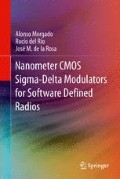Abstract
SINCE THE INFORMATION TECHNOLOGY (IT) AGE BEGAN AROUND 25 YEARS AGO with the commercialization of first personal computers, a number of digital electronic devices (audio/video players, cameras, cell phones, etc) have transformed the lifestyle of billions of people all over the world. The majority of these devices—empowered by microelectronic technology innovations—have been gradually connected to the Internet, thus giving rise to what has been called the first wave of the digital revolution. In the first decade of twenty-first century, Internet-based devices have experienced an explosive growth with the continuous increase of both wired and wireless broadband access services, thus enabling the proliferation of interactive social-networking activities, more and more multimedia contents, as well as new personalized on-line experiences on a single mobile hand-held terminal. All this has lead to the run up of the age of the second wave of the digital revolution [Lim08].
Access this chapter
Tax calculation will be finalised at checkout
Purchases are for personal use only
Notes
- 1.
The performance of a radio receiver is mainly characterized by two figures: sensitivity and selectivity. The former measures the ability to detect signals in the absence of any interference other than noise, while the latter characterizes the capacity of the receiver to discriminate between the desired signal and large adjacent-channel interferers. A detailed description of these and other receiver metrics—beyond the scope of this book—can be found in [Raza98, Lee04].
- 2.
The performance of an ADC can be quantified in terms of two main specifications: effective resolution (measured in bits) and bandwidth of the digitized signal. These terms will explained in detail in Chap. 2.
- 3.
This is the most common situation in practice, as will be detailed in Sect. 1.2.
- 4.
The term flexibility used in this work is defined as the ability of circuits and systems to reconfigure their topology and to adapt their performance to different specifications.
- 5.
Data have been mainly collected from papers published in the IEEE Journal of Solid-State Circuits and in the IEEE International Solid-State Circuits Conference.
- 6.
Note that the transceiver presented in [Inge10] seems to cover the specifications of the major 4G standards from the multi-band LNA to the ADC.
- 7.
Fundamentals, basic architectures and state-of-the-art performance of SD modulators will be described in detail in Chap. 2.
- 8.
Indeed, the use of SD modulation techniques may benefit from CT circuits to implement CMOS data converters operating within the GHz band [Ryck09] and, what is more important, many radio functions like blocker-rejection filtering, frequency-mixing process, channel-selection, etc, can be embedded within the SD converter architecture, thus simplifying that of the transceiver (in terms of circuit complexity and number of building blocks), as well as allowing to be adaptable and digitally programmable with high degree of robustness. However, the price to pay is very demanding ADC specifications of linearity, clock jitter and circuit element tolerances and mismatches, apart from their multiple trade-offs with power dissipation [Kim09].
- 9.
The analog-to-digital interface is made up of the ADC in the receiver and the DAC in the transmitter. Ideally, these blocks perform complementary data conversions from analog-to-digital and from digital-to-analog sides. However the requirements imposed by many wireless standards to the former are much more tougher to meet [Isma07], making its design much more complicated and critical than in the case of multi-standard DACs, which normally rely on reconfigurable current-steering architectures [Basc06].
- 10.
A good example of the RF-to-digital conversion approach has been recently published in [Ryck09]. This ADC, consisting on a band-pass CMOS CT SD converter, uses the so-called undersampling technique [Nade08] to digitize 2.4-GHz centered signals using a sampling frequency of 3 GHz. The operation frequency is tuned by varying tank capacitors. Recently, the concept of IF digitization using band-pass SC SD ADCs has been also successfully demonstrated in [Yama08] and [Lu10], the former being able to program the carrier frequency from DC to 1/3 of the sampling frequency,.
- 11.
According to the Nyquist theorem, the minimum value of the sampling frequency—often referred to as Nyquist frequency and represented by—must be twice the signal bandwidth; i.e.,. Based on this criterion, those ADCs with a sampling frequency, are called Nyquist-rate ADCs, while if, the resulting ADCs are known as oversampling ADCs, and is defined as the oversampling ratio.
- 12.
The data in this figure are classified according to the main types of SDMs. This will be described in detail in Chap. 2.
Author information
Authors and Affiliations
Corresponding author
Rights and permissions
Copyright information
© 2011 Springer Science+Business Media, LLC
About this chapter
Cite this chapter
Morgado, A., del Río, R., de la Rosa, J.M. (2011). Introduction. In: Nanometer CMOS Sigma-Delta Modulators for Software Defined Radio. Springer, New York, NY. https://doi.org/10.1007/978-1-4614-0037-0_1
Download citation
DOI: https://doi.org/10.1007/978-1-4614-0037-0_1
Published:
Publisher Name: Springer, New York, NY
Print ISBN: 978-1-4614-0036-3
Online ISBN: 978-1-4614-0037-0
eBook Packages: EngineeringEngineering (R0)

